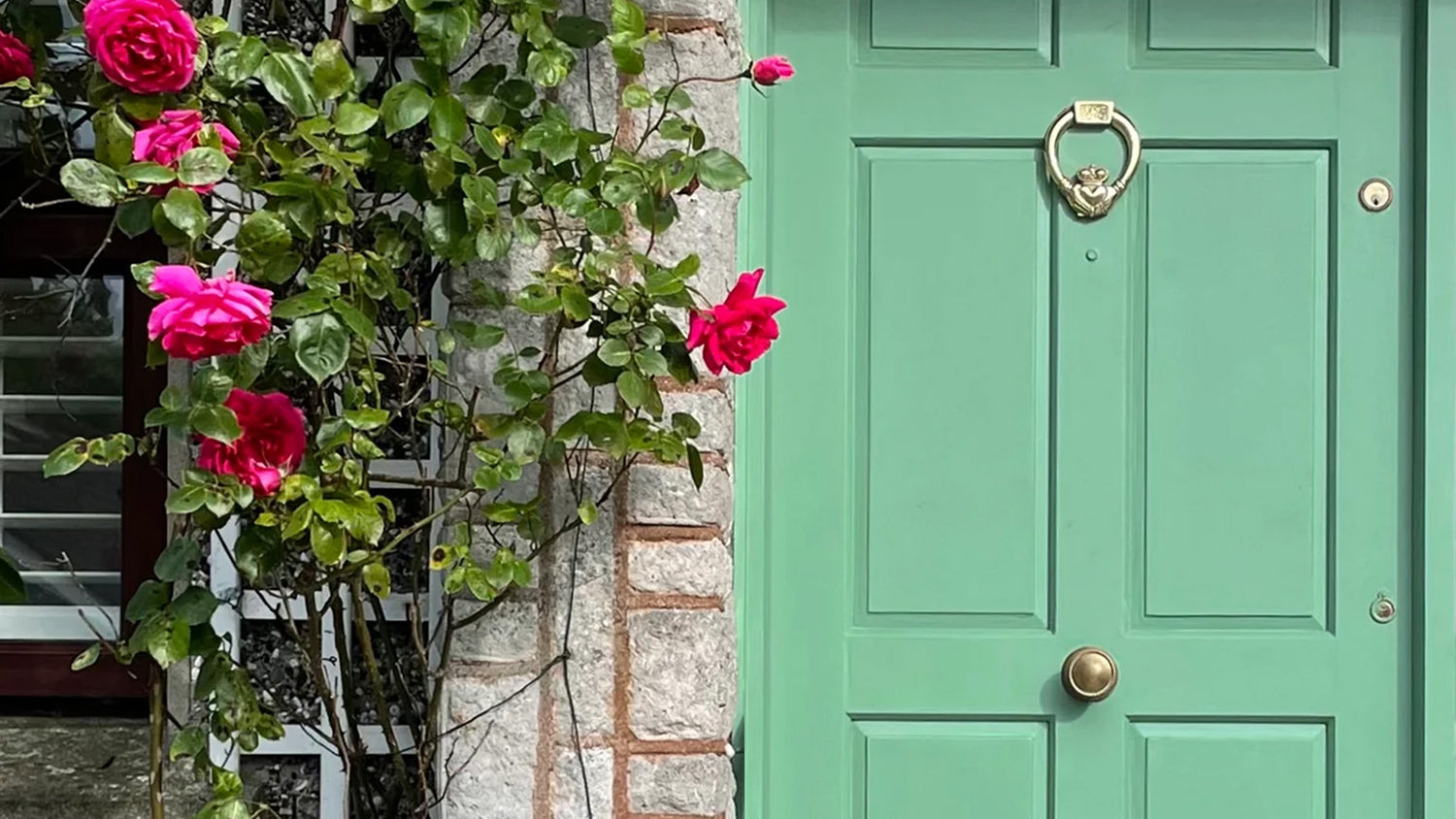Key FAQ Points:
- Yes, it is possible to paint almost all front doors with great results.
- The steps are the same for wooden, uPVC or composite doors.
- You’ll need to make sure your door is structurally sound, clean and scuff-sanded to help the paint adhere. Choose a self-priming paint to avoid the faff of applying a primer.
- The weather conditions also need to be right, avoiding rainfall, direct sunlight, high humidity and extremes of heat or cold while painting and for 48 hours afterwards.
Painting different front door materials
In short, the answer is yes – you can paint your front door. Whether it’s wooden, composite or uPVC, the steps are broadly similar for painting all front doors:
- Check the condition of your front door to make sure it’s structurally sound.
- Clean the surface using Sugar Soap diluted in warm water then rinse with clean water.
- Lightly sand with medium-grit sandpaper – this provides a ‘key’ which maximises paint adherence.
- Mask off any areas you don’t want to be painted – including any seals (which should not be painted).
- Apply with a brush, roller or sprayer.
We’ll dig deeper into each of these steps below. However, we’ve also put together specific guides for each material to eliminate any guesswork:
Preparing your front door for painting
Preparation is vital when painting any furniture or fixture. Your front door is no exception. The three main areas are assessing its overall condition, cleaning and sanding.
Checking your door’s condition
While we said what types of doors can be painted, it’s important to check your particular door is in suitable condition. Rotten wooden doors or uPVC doors that have warped, or have blown panels, are not suitable for painting. We also recommend you check your manufacturer's guarantee. While it might refresh their appearance temporarily, it won’t solve their underlying problems and you’ll still need to replace your front door in time.
Cleaning the door down
Sugar Soap is a quick and easy way to remove dirt and grime that get in the way of paint on your front door. Mix one part with ten parts warm water, then use a sponge to scrub the entire surface. Rinse with cold water when you’re done, and your front door will be clean enough to paint.
Sanding the door’s surface
Before you get the paint out, you’ll need to sand down your front door’s surface. Once the door is dry from rinsing, use sandpaper or a sanding sponge (medium grit). You can also use an electric sander if you have one.
You don’t need to sand too thoroughly. It’s just to give the surface a ‘key’, which gives the paint something to grip onto. Make sure all dust is cleared off the door before painting – and always wear a dust mask when sanding too.
Learn more in our guide to surface preparation.
Painting in suitable conditions
With front doors exposed to the elements, it’s important that you check the weather forecast before starting your transformation. Conditions need to be right while painting and in the 48 hours that follow, so the paint can properly cure.
As discussed in our FAQ on weather conditions, there are X elements to consider:
- Heat – Aim for a temperature below 32°C
- Cold – Make sure the temperature stays above 10°C, including the colder night-time.
- Rainfall – Needless to say, rainfall is another no-go for painting and curing.
- Humidity – Look for humidity levels between 40% and 70%.
- Direct sunlight – Avoid direct sunlight, which can also cause paint to dry too quickly.
Supplies for painting your front door
Next, you’ll need to get your supplies ready. It can take much longer to paint a front door if you have to keep stopping and starting every time you need something else.
Here’s a list of what you’ll need:
- Exterior paint (self-priming)
- Sugar Soap with a cloth or sponge
- Dust sheets and PPE
- Sandpaper, a sanding block or an electric sander
- Paint brushes and/or rollers or a sprayer if you choose!
- Masking tape (and cardboard/polythene if you have glass panels)
This is a summary of what’s required. We run through some more specific supplies in our guide: What Supplies Do I Need to Paint Furniture?
Of course, the paint you choose is arguably the most important supply of all. It should be self-priming for your convenience, weatherproof for protection against rain and UV rays, and suitable for the material you’re painting. We’ve covered all of this in our post on the best paint for uPVC doors & windows. Frenchic’s weatherproof Al Fresco range has no problem adhering to wood, composite or uPVC.
Choosing your colour or design
The final (and most fun) thing to think about is what colour you want your front door. With 26 permanent colours in our Al Fresco range, plus some exciting limited-edition shades, there’s plenty to choose from for your front door.
Greys are always popular for front doors. Our deep mid-grey, Greyhound, is particularly popular for front door transformations. Use a bright white like Dazzle Me! on the door frame to make it stand out even more!
Greens are another timeless colour for your home’s façade. You can create a classic look with a vintage green like Victory Lane on your front door. Or how about using Wise Old Sage for a country cottage or modern, botanical look?
Looking to add a pop of warmth? Try a pop of pink with Dusky Blush. Alternatively, go for something cold and bold with Steel Teal on your front door.
Check out even more door and front door makeovers for inspiration.








